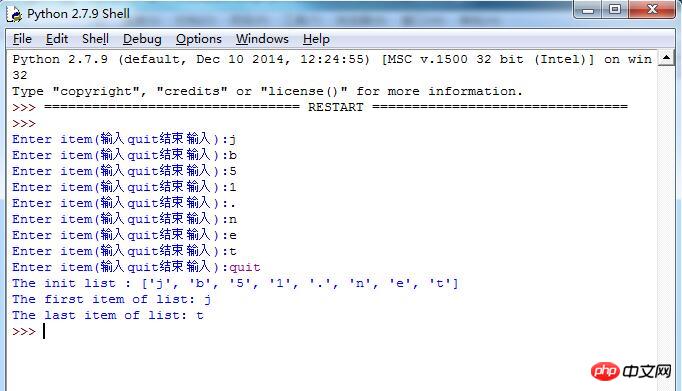这篇文章主要介绍了Python基于list的append和pop方法实现堆栈与队列功能,结合实例形式分析了Python使用list定义及使用队列的相关操作技巧,需要的朋友可以参考下
本文实例讲述了Python基于list的append和pop方法实现堆栈与队列功能。分享给大家供大家参考,具体如下:
#coding=utf8
'''''
堆栈:
堆栈是一个后进先出(LIFO)的数据结构。
在栈上"push"元素是个常用术语,意思是把一个对象添加到堆栈中。
删除一个元素,可以把它"pop"出堆栈。
队列:
队列是一种先进先出(FIFO)的数据类型。
新的元素通过"入队"的方式添加进队列的末尾,
"出对"就是从队列的头部删除。
'''
#创建列表
def creatList():
initList=[]
try:
while True:
#从键上输入元素
inputItem=raw_input(u"Enter item(输入quit结束输入):")
#当输入字符不是quit,把元素加入列表
#当输入字符是quit,结束输入
if inputItem!="quit":
initList.append(inputItem.strip())
else:
break
#返回输入列表
return initList
except Exception,e:
print "Create List Error:",e
#删除列表的第一个元素并返回删除元素
def popTheFirst(List):
try:
#判断列表中是否存在元素
#如果存在元素,删除并返回第一个元素
#如果不存在,给出提示信息
if len(List)>0:
return List.pop(0)
else:
print "The list is empty..."
except Exception,e:
print "pop the first item Error:",e
#删除列表的最后元素并返回删除元素
def popTheLast(List):
try:
#判断列表中是否存在元素
#如果存在元素,删除并返回最后元素
#如果不存在,给出提示信息
if len(List)>0:
#pop函数默认删除最后一个元素
return List.pop()
else:
print "The list is empty..."
except Exception,e:
print "pop the last item Error:",e
#调用creatList函数创建表
listOne=creatList()
#输出创建表信息
print "The init list :",listOne
#调用popTheFirst函数删除并返回第一个元素
theFirst=popTheFirst(listOne)
#输出当前表的第一个元素
print "The first item of list:",theFirst
#调用popTheFirst函数删除并返回最后一个元素
theLast=popTheLast(listOne)
#输出当前表的最后一个元素元素
print "The last item of list:",theLast
'''''
这里的listOne、theFirst、theLast都是全局变量
如果更改上述语句顺序会获取不到想要的结果。
'''运行结果:

Atas ialah kandungan terperinci Python实现堆栈与队列功能(基于list的append与pop方法)的示例. Untuk maklumat lanjut, sila ikut artikel berkaitan lain di laman web China PHP!
 Python dan Masa: Memanfaatkan masa belajar andaApr 14, 2025 am 12:02 AM
Python dan Masa: Memanfaatkan masa belajar andaApr 14, 2025 am 12:02 AMUntuk memaksimumkan kecekapan pembelajaran Python dalam masa yang terhad, anda boleh menggunakan modul, masa, dan modul Python. 1. Modul DateTime digunakan untuk merakam dan merancang masa pembelajaran. 2. Modul Masa membantu menetapkan kajian dan masa rehat. 3. Modul Jadual secara automatik mengatur tugas pembelajaran mingguan.
 Python: Permainan, GUI, dan banyak lagiApr 13, 2025 am 12:14 AM
Python: Permainan, GUI, dan banyak lagiApr 13, 2025 am 12:14 AMPython cemerlang dalam permainan dan pembangunan GUI. 1) Pembangunan permainan menggunakan pygame, menyediakan lukisan, audio dan fungsi lain, yang sesuai untuk membuat permainan 2D. 2) Pembangunan GUI boleh memilih tkinter atau pyqt. TKInter adalah mudah dan mudah digunakan, PYQT mempunyai fungsi yang kaya dan sesuai untuk pembangunan profesional.
 Python vs C: Aplikasi dan kes penggunaan dibandingkanApr 12, 2025 am 12:01 AM
Python vs C: Aplikasi dan kes penggunaan dibandingkanApr 12, 2025 am 12:01 AMPython sesuai untuk sains data, pembangunan web dan tugas automasi, manakala C sesuai untuk pengaturcaraan sistem, pembangunan permainan dan sistem tertanam. Python terkenal dengan kesederhanaan dan ekosistem yang kuat, manakala C dikenali dengan keupayaan kawalan dan keupayaan kawalan yang mendasari.
 Rancangan Python 2 jam: Pendekatan yang realistikApr 11, 2025 am 12:04 AM
Rancangan Python 2 jam: Pendekatan yang realistikApr 11, 2025 am 12:04 AMAnda boleh mempelajari konsep pengaturcaraan asas dan kemahiran Python dalam masa 2 jam. 1. Belajar Pembolehubah dan Jenis Data, 2.
 Python: meneroka aplikasi utamanyaApr 10, 2025 am 09:41 AM
Python: meneroka aplikasi utamanyaApr 10, 2025 am 09:41 AMPython digunakan secara meluas dalam bidang pembangunan web, sains data, pembelajaran mesin, automasi dan skrip. 1) Dalam pembangunan web, kerangka Django dan Flask memudahkan proses pembangunan. 2) Dalam bidang sains data dan pembelajaran mesin, numpy, panda, scikit-learn dan perpustakaan tensorflow memberikan sokongan yang kuat. 3) Dari segi automasi dan skrip, Python sesuai untuk tugas -tugas seperti ujian automatik dan pengurusan sistem.
 Berapa banyak python yang boleh anda pelajari dalam 2 jam?Apr 09, 2025 pm 04:33 PM
Berapa banyak python yang boleh anda pelajari dalam 2 jam?Apr 09, 2025 pm 04:33 PMAnda boleh mempelajari asas -asas Python dalam masa dua jam. 1. Belajar pembolehubah dan jenis data, 2. Struktur kawalan induk seperti jika pernyataan dan gelung, 3 memahami definisi dan penggunaan fungsi. Ini akan membantu anda mula menulis program python mudah.
 Bagaimana Mengajar Asas Pengaturcaraan Pemula Komputer Dalam Kaedah Projek dan Masalah Dikemukakan Dalam masa 10 Jam?Apr 02, 2025 am 07:18 AM
Bagaimana Mengajar Asas Pengaturcaraan Pemula Komputer Dalam Kaedah Projek dan Masalah Dikemukakan Dalam masa 10 Jam?Apr 02, 2025 am 07:18 AMBagaimana Mengajar Asas Pengaturcaraan Pemula Komputer Dalam masa 10 jam? Sekiranya anda hanya mempunyai 10 jam untuk mengajar pemula komputer beberapa pengetahuan pengaturcaraan, apa yang akan anda pilih untuk mengajar ...
 Bagaimana untuk mengelakkan dikesan oleh penyemak imbas apabila menggunakan fiddler di mana-mana untuk membaca lelaki-dalam-tengah?Apr 02, 2025 am 07:15 AM
Bagaimana untuk mengelakkan dikesan oleh penyemak imbas apabila menggunakan fiddler di mana-mana untuk membaca lelaki-dalam-tengah?Apr 02, 2025 am 07:15 AMCara mengelakkan dikesan semasa menggunakan fiddlerevery di mana untuk bacaan lelaki-dalam-pertengahan apabila anda menggunakan fiddlerevery di mana ...


Alat AI Hot

Undresser.AI Undress
Apl berkuasa AI untuk mencipta foto bogel yang realistik

AI Clothes Remover
Alat AI dalam talian untuk mengeluarkan pakaian daripada foto.

Undress AI Tool
Gambar buka pakaian secara percuma

Clothoff.io
Penyingkiran pakaian AI

AI Hentai Generator
Menjana ai hentai secara percuma.

Artikel Panas

Alat panas

VSCode Windows 64-bit Muat Turun
Editor IDE percuma dan berkuasa yang dilancarkan oleh Microsoft

Dreamweaver CS6
Alat pembangunan web visual

Versi Mac WebStorm
Alat pembangunan JavaScript yang berguna

Pelayar Peperiksaan Selamat
Pelayar Peperiksaan Selamat ialah persekitaran pelayar selamat untuk mengambil peperiksaan dalam talian dengan selamat. Perisian ini menukar mana-mana komputer menjadi stesen kerja yang selamat. Ia mengawal akses kepada mana-mana utiliti dan menghalang pelajar daripada menggunakan sumber yang tidak dibenarkan.

Hantar Studio 13.0.1
Persekitaran pembangunan bersepadu PHP yang berkuasa





